Academic Skills: Leadership and Its Impact on Employee Performance
VerifiedAdded on 2023/01/10
|7
|1977
|39
Literature Review
AI Summary
This literature review explores the multifaceted impact of leadership on employee performance, drawing on various scholarly sources and research findings. The review begins with an introduction emphasizing the significance of academic skills in building confidence and achieving goals, particularly in the context of organizational employees. The main body delves into the topic of leadership and its effects on employee performance, contrasting viewpoints from different authors and analyzing previous research. Key themes include the positive and negative roles of leadership, the influence of leadership styles on employee behavior and attitudes, and the impact of leadership on employee engagement, innovation, and productivity. The review also examines the role of leadership in creating a supportive work environment, fostering employee recognition, and promoting ethical behavior. Furthermore, the review discusses the dynamic impacts of leadership, the importance of employee recognition, and the potential for leadership to influence employee performance both directly and indirectly. The literature review also considers the impact of leadership on employee morale, job satisfaction, and turnover, with the conclusion summarizing the key findings and highlighting the need for further research to fully understand the impacts of leadership on employee performance. The references include a list of books, journals and online resources that support the arguments.

Academic Skills Studying
With Confidence
With Confidence
Paraphrase This Document
Need a fresh take? Get an instant paraphrase of this document with our AI Paraphraser
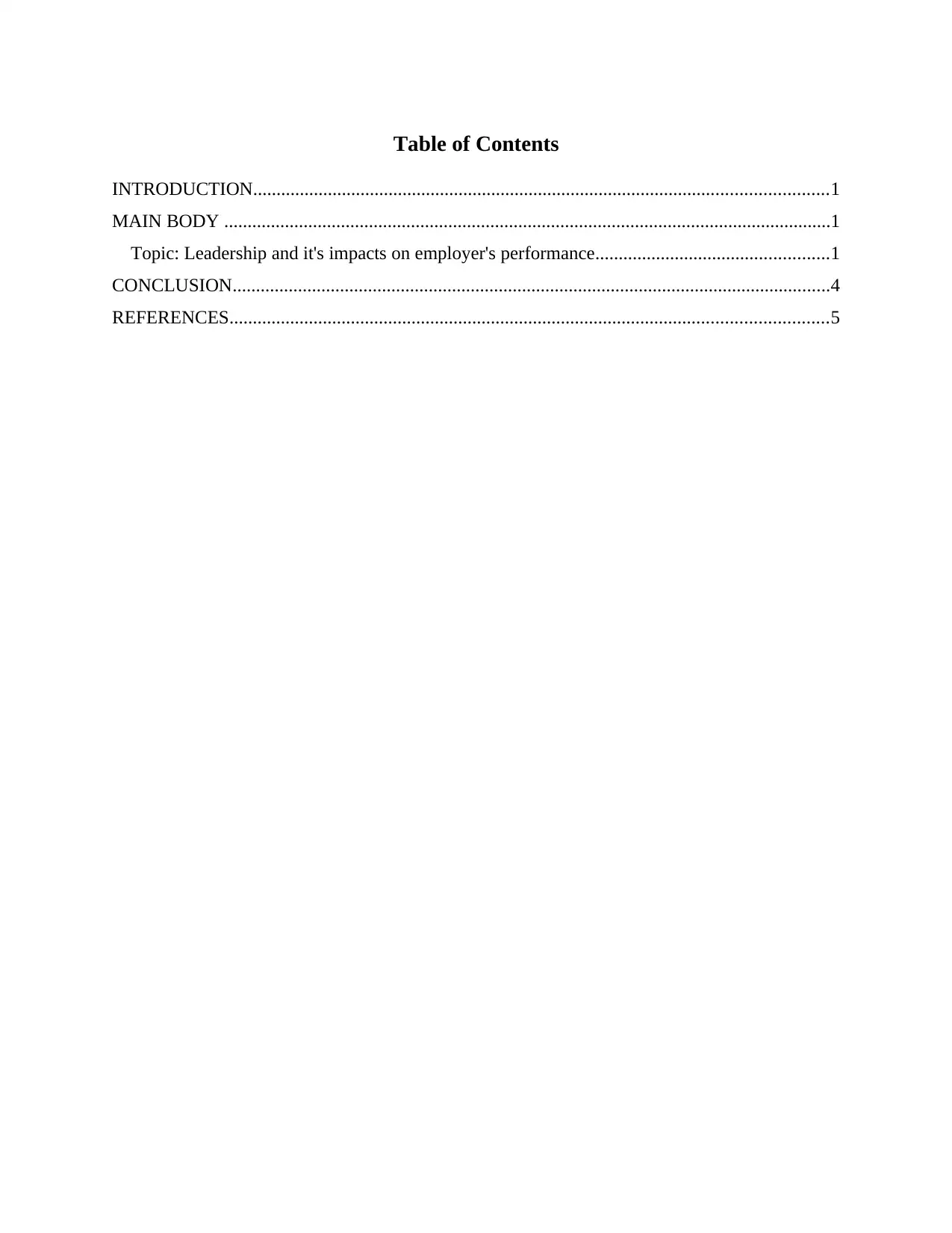
Table of Contents
INTRODUCTION...........................................................................................................................1
MAIN BODY ..................................................................................................................................1
Topic: Leadership and it's impacts on employer's performance..................................................1
CONCLUSION................................................................................................................................4
REFERENCES................................................................................................................................5
INTRODUCTION...........................................................................................................................1
MAIN BODY ..................................................................................................................................1
Topic: Leadership and it's impacts on employer's performance..................................................1
CONCLUSION................................................................................................................................4
REFERENCES................................................................................................................................5
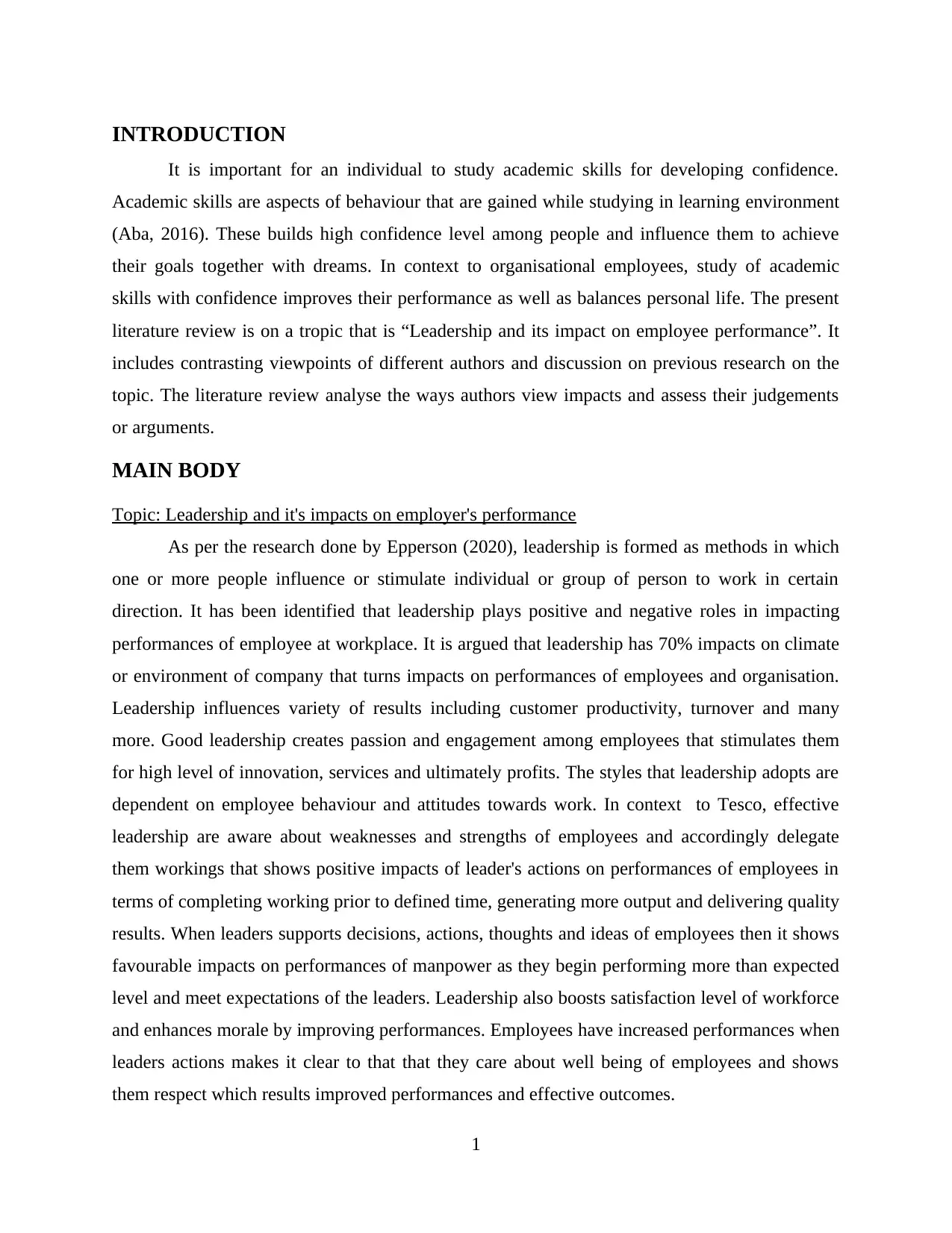
INTRODUCTION
It is important for an individual to study academic skills for developing confidence.
Academic skills are aspects of behaviour that are gained while studying in learning environment
(Aba, 2016). These builds high confidence level among people and influence them to achieve
their goals together with dreams. In context to organisational employees, study of academic
skills with confidence improves their performance as well as balances personal life. The present
literature review is on a tropic that is “Leadership and its impact on employee performance”. It
includes contrasting viewpoints of different authors and discussion on previous research on the
topic. The literature review analyse the ways authors view impacts and assess their judgements
or arguments.
MAIN BODY
Topic: Leadership and it's impacts on employer's performance
As per the research done by Epperson (2020), leadership is formed as methods in which
one or more people influence or stimulate individual or group of person to work in certain
direction. It has been identified that leadership plays positive and negative roles in impacting
performances of employee at workplace. It is argued that leadership has 70% impacts on climate
or environment of company that turns impacts on performances of employees and organisation.
Leadership influences variety of results including customer productivity, turnover and many
more. Good leadership creates passion and engagement among employees that stimulates them
for high level of innovation, services and ultimately profits. The styles that leadership adopts are
dependent on employee behaviour and attitudes towards work. In context to Tesco, effective
leadership are aware about weaknesses and strengths of employees and accordingly delegate
them workings that shows positive impacts of leader's actions on performances of employees in
terms of completing working prior to defined time, generating more output and delivering quality
results. When leaders supports decisions, actions, thoughts and ideas of employees then it shows
favourable impacts on performances of manpower as they begin performing more than expected
level and meet expectations of the leaders. Leadership also boosts satisfaction level of workforce
and enhances morale by improving performances. Employees have increased performances when
leaders actions makes it clear to that that they care about well being of employees and shows
them respect which results improved performances and effective outcomes.
1
It is important for an individual to study academic skills for developing confidence.
Academic skills are aspects of behaviour that are gained while studying in learning environment
(Aba, 2016). These builds high confidence level among people and influence them to achieve
their goals together with dreams. In context to organisational employees, study of academic
skills with confidence improves their performance as well as balances personal life. The present
literature review is on a tropic that is “Leadership and its impact on employee performance”. It
includes contrasting viewpoints of different authors and discussion on previous research on the
topic. The literature review analyse the ways authors view impacts and assess their judgements
or arguments.
MAIN BODY
Topic: Leadership and it's impacts on employer's performance
As per the research done by Epperson (2020), leadership is formed as methods in which
one or more people influence or stimulate individual or group of person to work in certain
direction. It has been identified that leadership plays positive and negative roles in impacting
performances of employee at workplace. It is argued that leadership has 70% impacts on climate
or environment of company that turns impacts on performances of employees and organisation.
Leadership influences variety of results including customer productivity, turnover and many
more. Good leadership creates passion and engagement among employees that stimulates them
for high level of innovation, services and ultimately profits. The styles that leadership adopts are
dependent on employee behaviour and attitudes towards work. In context to Tesco, effective
leadership are aware about weaknesses and strengths of employees and accordingly delegate
them workings that shows positive impacts of leader's actions on performances of employees in
terms of completing working prior to defined time, generating more output and delivering quality
results. When leaders supports decisions, actions, thoughts and ideas of employees then it shows
favourable impacts on performances of manpower as they begin performing more than expected
level and meet expectations of the leaders. Leadership also boosts satisfaction level of workforce
and enhances morale by improving performances. Employees have increased performances when
leaders actions makes it clear to that that they care about well being of employees and shows
them respect which results improved performances and effective outcomes.
1
⊘ This is a preview!⊘
Do you want full access?
Subscribe today to unlock all pages.

Trusted by 1+ million students worldwide
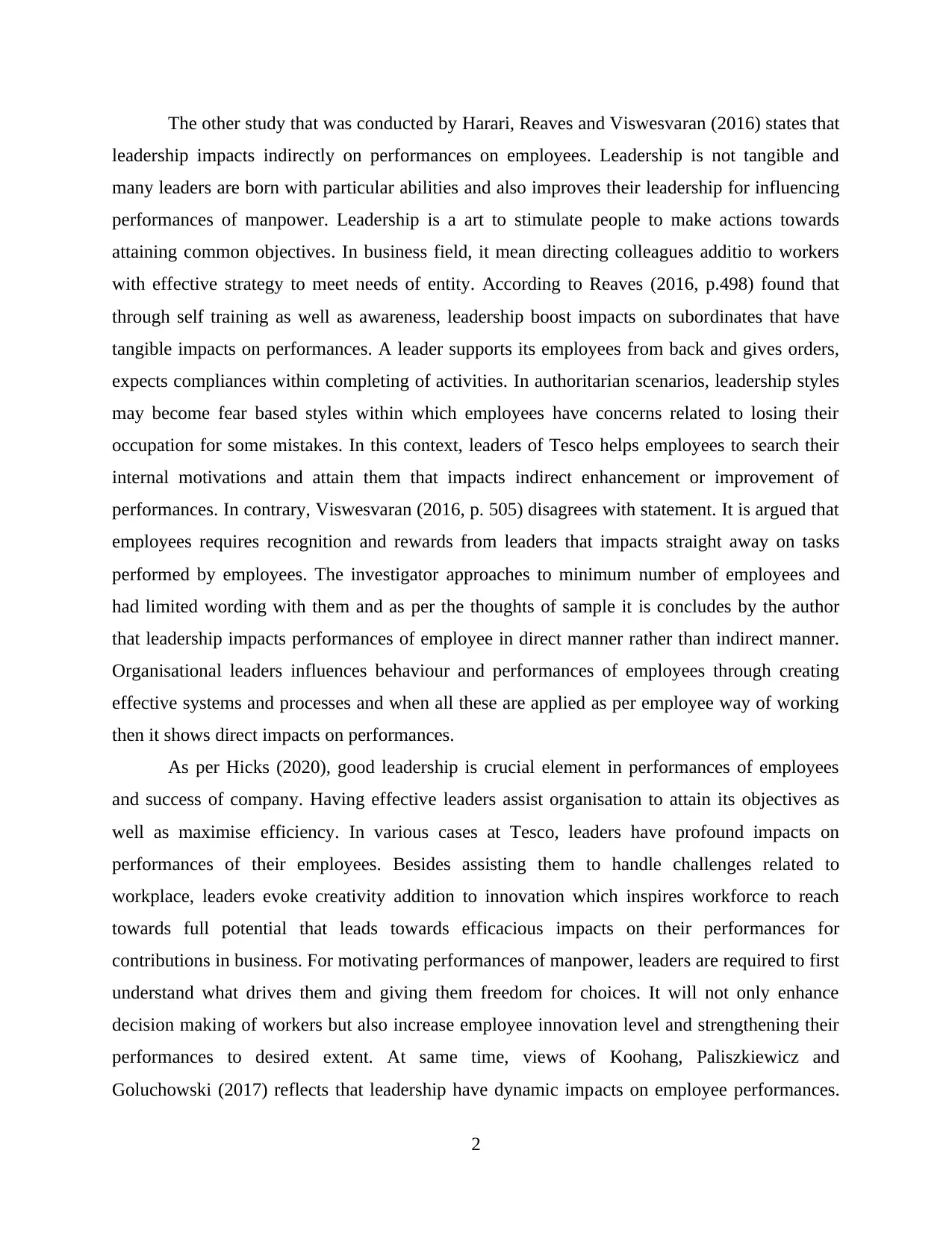
The other study that was conducted by Harari, Reaves and Viswesvaran (2016) states that
leadership impacts indirectly on performances on employees. Leadership is not tangible and
many leaders are born with particular abilities and also improves their leadership for influencing
performances of manpower. Leadership is a art to stimulate people to make actions towards
attaining common objectives. In business field, it mean directing colleagues additio to workers
with effective strategy to meet needs of entity. According to Reaves (2016, p.498) found that
through self training as well as awareness, leadership boost impacts on subordinates that have
tangible impacts on performances. A leader supports its employees from back and gives orders,
expects compliances within completing of activities. In authoritarian scenarios, leadership styles
may become fear based styles within which employees have concerns related to losing their
occupation for some mistakes. In this context, leaders of Tesco helps employees to search their
internal motivations and attain them that impacts indirect enhancement or improvement of
performances. In contrary, Viswesvaran (2016, p. 505) disagrees with statement. It is argued that
employees requires recognition and rewards from leaders that impacts straight away on tasks
performed by employees. The investigator approaches to minimum number of employees and
had limited wording with them and as per the thoughts of sample it is concludes by the author
that leadership impacts performances of employee in direct manner rather than indirect manner.
Organisational leaders influences behaviour and performances of employees through creating
effective systems and processes and when all these are applied as per employee way of working
then it shows direct impacts on performances.
As per Hicks (2020), good leadership is crucial element in performances of employees
and success of company. Having effective leaders assist organisation to attain its objectives as
well as maximise efficiency. In various cases at Tesco, leaders have profound impacts on
performances of their employees. Besides assisting them to handle challenges related to
workplace, leaders evoke creativity addition to innovation which inspires workforce to reach
towards full potential that leads towards efficacious impacts on their performances for
contributions in business. For motivating performances of manpower, leaders are required to first
understand what drives them and giving them freedom for choices. It will not only enhance
decision making of workers but also increase employee innovation level and strengthening their
performances to desired extent. At same time, views of Koohang, Paliszkiewicz and
Goluchowski (2017) reflects that leadership have dynamic impacts on employee performances.
2
leadership impacts indirectly on performances on employees. Leadership is not tangible and
many leaders are born with particular abilities and also improves their leadership for influencing
performances of manpower. Leadership is a art to stimulate people to make actions towards
attaining common objectives. In business field, it mean directing colleagues additio to workers
with effective strategy to meet needs of entity. According to Reaves (2016, p.498) found that
through self training as well as awareness, leadership boost impacts on subordinates that have
tangible impacts on performances. A leader supports its employees from back and gives orders,
expects compliances within completing of activities. In authoritarian scenarios, leadership styles
may become fear based styles within which employees have concerns related to losing their
occupation for some mistakes. In this context, leaders of Tesco helps employees to search their
internal motivations and attain them that impacts indirect enhancement or improvement of
performances. In contrary, Viswesvaran (2016, p. 505) disagrees with statement. It is argued that
employees requires recognition and rewards from leaders that impacts straight away on tasks
performed by employees. The investigator approaches to minimum number of employees and
had limited wording with them and as per the thoughts of sample it is concludes by the author
that leadership impacts performances of employee in direct manner rather than indirect manner.
Organisational leaders influences behaviour and performances of employees through creating
effective systems and processes and when all these are applied as per employee way of working
then it shows direct impacts on performances.
As per Hicks (2020), good leadership is crucial element in performances of employees
and success of company. Having effective leaders assist organisation to attain its objectives as
well as maximise efficiency. In various cases at Tesco, leaders have profound impacts on
performances of their employees. Besides assisting them to handle challenges related to
workplace, leaders evoke creativity addition to innovation which inspires workforce to reach
towards full potential that leads towards efficacious impacts on their performances for
contributions in business. For motivating performances of manpower, leaders are required to first
understand what drives them and giving them freedom for choices. It will not only enhance
decision making of workers but also increase employee innovation level and strengthening their
performances to desired extent. At same time, views of Koohang, Paliszkiewicz and
Goluchowski (2017) reflects that leadership have dynamic impacts on employee performances.
2
Paraphrase This Document
Need a fresh take? Get an instant paraphrase of this document with our AI Paraphraser
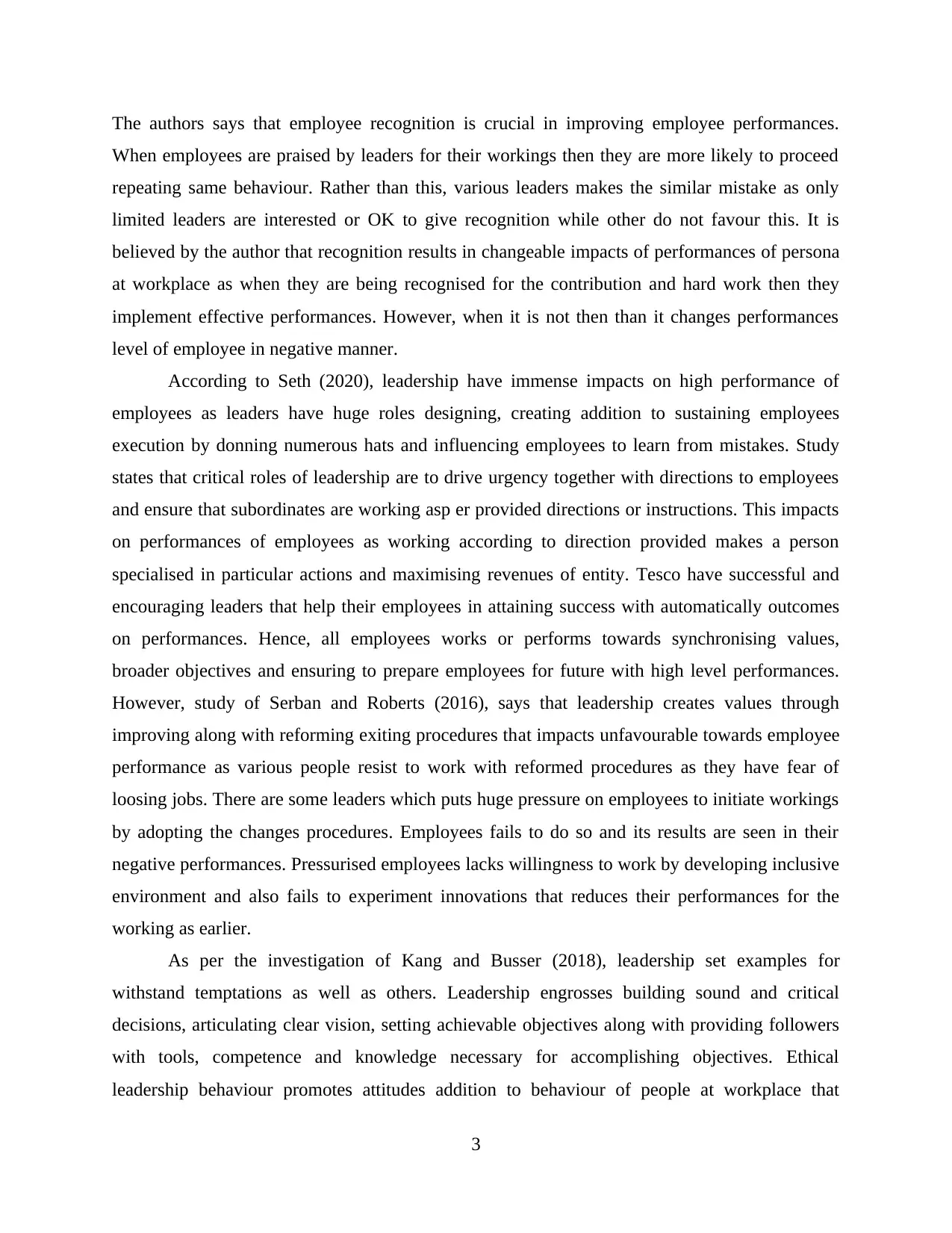
The authors says that employee recognition is crucial in improving employee performances.
When employees are praised by leaders for their workings then they are more likely to proceed
repeating same behaviour. Rather than this, various leaders makes the similar mistake as only
limited leaders are interested or OK to give recognition while other do not favour this. It is
believed by the author that recognition results in changeable impacts of performances of persona
at workplace as when they are being recognised for the contribution and hard work then they
implement effective performances. However, when it is not then than it changes performances
level of employee in negative manner.
According to Seth (2020), leadership have immense impacts on high performance of
employees as leaders have huge roles designing, creating addition to sustaining employees
execution by donning numerous hats and influencing employees to learn from mistakes. Study
states that critical roles of leadership are to drive urgency together with directions to employees
and ensure that subordinates are working asp er provided directions or instructions. This impacts
on performances of employees as working according to direction provided makes a person
specialised in particular actions and maximising revenues of entity. Tesco have successful and
encouraging leaders that help their employees in attaining success with automatically outcomes
on performances. Hence, all employees works or performs towards synchronising values,
broader objectives and ensuring to prepare employees for future with high level performances.
However, study of Serban and Roberts (2016), says that leadership creates values through
improving along with reforming exiting procedures that impacts unfavourable towards employee
performance as various people resist to work with reformed procedures as they have fear of
loosing jobs. There are some leaders which puts huge pressure on employees to initiate workings
by adopting the changes procedures. Employees fails to do so and its results are seen in their
negative performances. Pressurised employees lacks willingness to work by developing inclusive
environment and also fails to experiment innovations that reduces their performances for the
working as earlier.
As per the investigation of Kang and Busser (2018), leadership set examples for
withstand temptations as well as others. Leadership engrosses building sound and critical
decisions, articulating clear vision, setting achievable objectives along with providing followers
with tools, competence and knowledge necessary for accomplishing objectives. Ethical
leadership behaviour promotes attitudes addition to behaviour of people at workplace that
3
When employees are praised by leaders for their workings then they are more likely to proceed
repeating same behaviour. Rather than this, various leaders makes the similar mistake as only
limited leaders are interested or OK to give recognition while other do not favour this. It is
believed by the author that recognition results in changeable impacts of performances of persona
at workplace as when they are being recognised for the contribution and hard work then they
implement effective performances. However, when it is not then than it changes performances
level of employee in negative manner.
According to Seth (2020), leadership have immense impacts on high performance of
employees as leaders have huge roles designing, creating addition to sustaining employees
execution by donning numerous hats and influencing employees to learn from mistakes. Study
states that critical roles of leadership are to drive urgency together with directions to employees
and ensure that subordinates are working asp er provided directions or instructions. This impacts
on performances of employees as working according to direction provided makes a person
specialised in particular actions and maximising revenues of entity. Tesco have successful and
encouraging leaders that help their employees in attaining success with automatically outcomes
on performances. Hence, all employees works or performs towards synchronising values,
broader objectives and ensuring to prepare employees for future with high level performances.
However, study of Serban and Roberts (2016), says that leadership creates values through
improving along with reforming exiting procedures that impacts unfavourable towards employee
performance as various people resist to work with reformed procedures as they have fear of
loosing jobs. There are some leaders which puts huge pressure on employees to initiate workings
by adopting the changes procedures. Employees fails to do so and its results are seen in their
negative performances. Pressurised employees lacks willingness to work by developing inclusive
environment and also fails to experiment innovations that reduces their performances for the
working as earlier.
As per the investigation of Kang and Busser (2018), leadership set examples for
withstand temptations as well as others. Leadership engrosses building sound and critical
decisions, articulating clear vision, setting achievable objectives along with providing followers
with tools, competence and knowledge necessary for accomplishing objectives. Ethical
leadership behaviour promotes attitudes addition to behaviour of people at workplace that
3
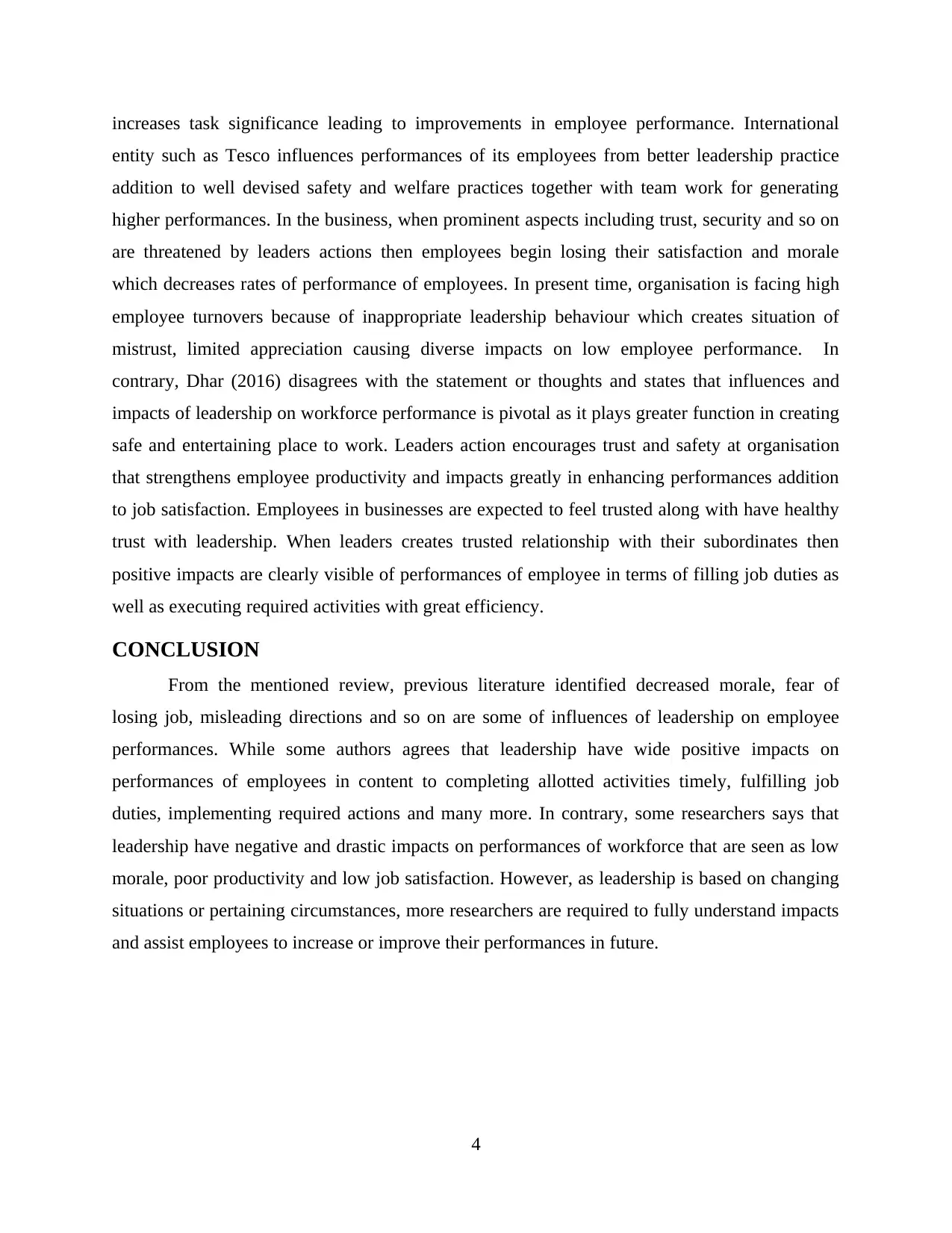
increases task significance leading to improvements in employee performance. International
entity such as Tesco influences performances of its employees from better leadership practice
addition to well devised safety and welfare practices together with team work for generating
higher performances. In the business, when prominent aspects including trust, security and so on
are threatened by leaders actions then employees begin losing their satisfaction and morale
which decreases rates of performance of employees. In present time, organisation is facing high
employee turnovers because of inappropriate leadership behaviour which creates situation of
mistrust, limited appreciation causing diverse impacts on low employee performance. In
contrary, Dhar (2016) disagrees with the statement or thoughts and states that influences and
impacts of leadership on workforce performance is pivotal as it plays greater function in creating
safe and entertaining place to work. Leaders action encourages trust and safety at organisation
that strengthens employee productivity and impacts greatly in enhancing performances addition
to job satisfaction. Employees in businesses are expected to feel trusted along with have healthy
trust with leadership. When leaders creates trusted relationship with their subordinates then
positive impacts are clearly visible of performances of employee in terms of filling job duties as
well as executing required activities with great efficiency.
CONCLUSION
From the mentioned review, previous literature identified decreased morale, fear of
losing job, misleading directions and so on are some of influences of leadership on employee
performances. While some authors agrees that leadership have wide positive impacts on
performances of employees in content to completing allotted activities timely, fulfilling job
duties, implementing required actions and many more. In contrary, some researchers says that
leadership have negative and drastic impacts on performances of workforce that are seen as low
morale, poor productivity and low job satisfaction. However, as leadership is based on changing
situations or pertaining circumstances, more researchers are required to fully understand impacts
and assist employees to increase or improve their performances in future.
4
entity such as Tesco influences performances of its employees from better leadership practice
addition to well devised safety and welfare practices together with team work for generating
higher performances. In the business, when prominent aspects including trust, security and so on
are threatened by leaders actions then employees begin losing their satisfaction and morale
which decreases rates of performance of employees. In present time, organisation is facing high
employee turnovers because of inappropriate leadership behaviour which creates situation of
mistrust, limited appreciation causing diverse impacts on low employee performance. In
contrary, Dhar (2016) disagrees with the statement or thoughts and states that influences and
impacts of leadership on workforce performance is pivotal as it plays greater function in creating
safe and entertaining place to work. Leaders action encourages trust and safety at organisation
that strengthens employee productivity and impacts greatly in enhancing performances addition
to job satisfaction. Employees in businesses are expected to feel trusted along with have healthy
trust with leadership. When leaders creates trusted relationship with their subordinates then
positive impacts are clearly visible of performances of employee in terms of filling job duties as
well as executing required activities with great efficiency.
CONCLUSION
From the mentioned review, previous literature identified decreased morale, fear of
losing job, misleading directions and so on are some of influences of leadership on employee
performances. While some authors agrees that leadership have wide positive impacts on
performances of employees in content to completing allotted activities timely, fulfilling job
duties, implementing required actions and many more. In contrary, some researchers says that
leadership have negative and drastic impacts on performances of workforce that are seen as low
morale, poor productivity and low job satisfaction. However, as leadership is based on changing
situations or pertaining circumstances, more researchers are required to fully understand impacts
and assist employees to increase or improve their performances in future.
4
⊘ This is a preview!⊘
Do you want full access?
Subscribe today to unlock all pages.

Trusted by 1+ million students worldwide
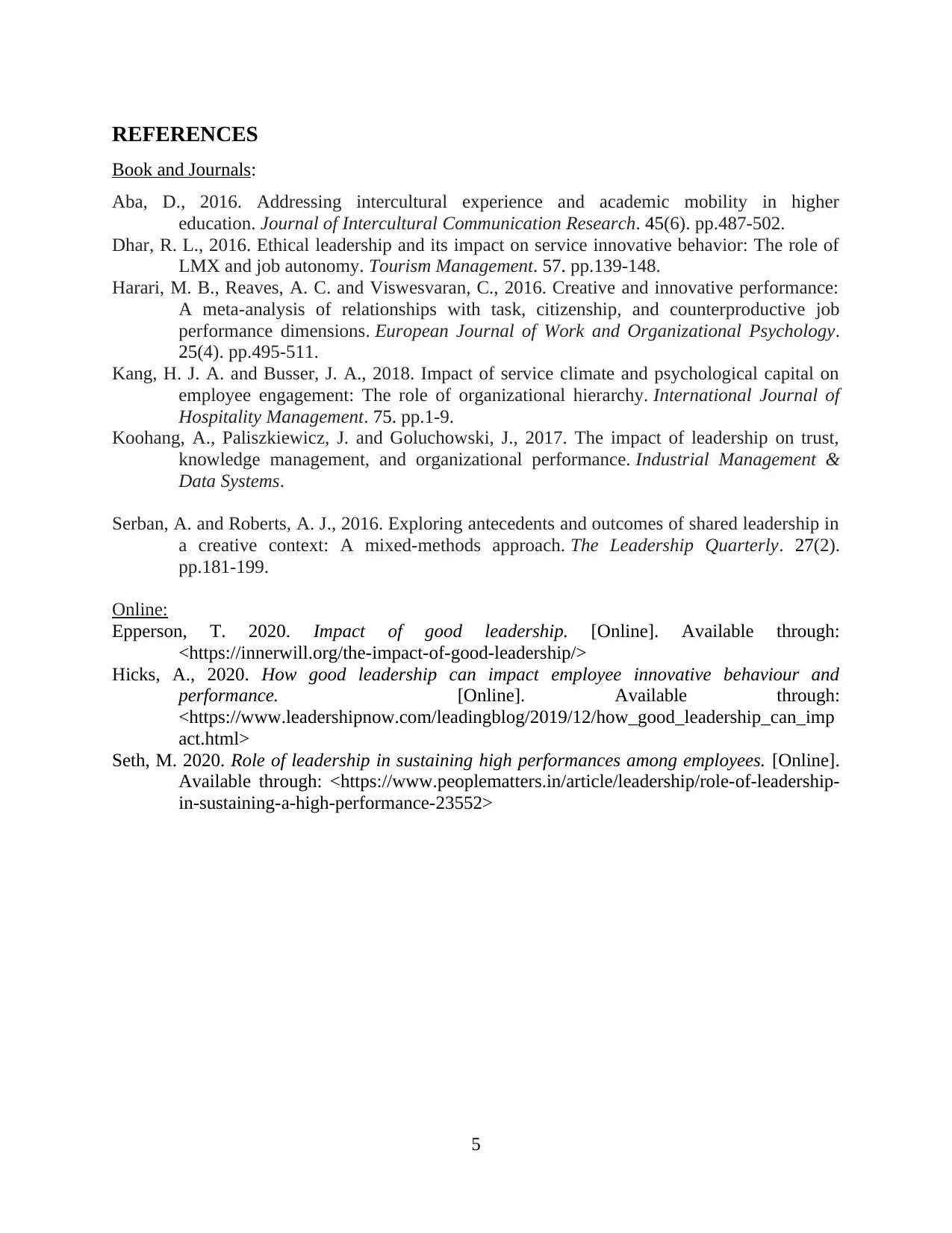
REFERENCES
Book and Journals:
Aba, D., 2016. Addressing intercultural experience and academic mobility in higher
education. Journal of Intercultural Communication Research. 45(6). pp.487-502.
Dhar, R. L., 2016. Ethical leadership and its impact on service innovative behavior: The role of
LMX and job autonomy. Tourism Management. 57. pp.139-148.
Harari, M. B., Reaves, A. C. and Viswesvaran, C., 2016. Creative and innovative performance:
A meta-analysis of relationships with task, citizenship, and counterproductive job
performance dimensions. European Journal of Work and Organizational Psychology.
25(4). pp.495-511.
Kang, H. J. A. and Busser, J. A., 2018. Impact of service climate and psychological capital on
employee engagement: The role of organizational hierarchy. International Journal of
Hospitality Management. 75. pp.1-9.
Koohang, A., Paliszkiewicz, J. and Goluchowski, J., 2017. The impact of leadership on trust,
knowledge management, and organizational performance. Industrial Management &
Data Systems.
Serban, A. and Roberts, A. J., 2016. Exploring antecedents and outcomes of shared leadership in
a creative context: A mixed-methods approach. The Leadership Quarterly. 27(2).
pp.181-199.
Online:
Epperson, T. 2020. Impact of good leadership. [Online]. Available through:
<https://innerwill.org/the-impact-of-good-leadership/>
Hicks, A., 2020. How good leadership can impact employee innovative behaviour and
performance. [Online]. Available through:
<https://www.leadershipnow.com/leadingblog/2019/12/how_good_leadership_can_imp
act.html>
Seth, M. 2020. Role of leadership in sustaining high performances among employees. [Online].
Available through: <https://www.peoplematters.in/article/leadership/role-of-leadership-
in-sustaining-a-high-performance-23552>
5
Book and Journals:
Aba, D., 2016. Addressing intercultural experience and academic mobility in higher
education. Journal of Intercultural Communication Research. 45(6). pp.487-502.
Dhar, R. L., 2016. Ethical leadership and its impact on service innovative behavior: The role of
LMX and job autonomy. Tourism Management. 57. pp.139-148.
Harari, M. B., Reaves, A. C. and Viswesvaran, C., 2016. Creative and innovative performance:
A meta-analysis of relationships with task, citizenship, and counterproductive job
performance dimensions. European Journal of Work and Organizational Psychology.
25(4). pp.495-511.
Kang, H. J. A. and Busser, J. A., 2018. Impact of service climate and psychological capital on
employee engagement: The role of organizational hierarchy. International Journal of
Hospitality Management. 75. pp.1-9.
Koohang, A., Paliszkiewicz, J. and Goluchowski, J., 2017. The impact of leadership on trust,
knowledge management, and organizational performance. Industrial Management &
Data Systems.
Serban, A. and Roberts, A. J., 2016. Exploring antecedents and outcomes of shared leadership in
a creative context: A mixed-methods approach. The Leadership Quarterly. 27(2).
pp.181-199.
Online:
Epperson, T. 2020. Impact of good leadership. [Online]. Available through:
<https://innerwill.org/the-impact-of-good-leadership/>
Hicks, A., 2020. How good leadership can impact employee innovative behaviour and
performance. [Online]. Available through:
<https://www.leadershipnow.com/leadingblog/2019/12/how_good_leadership_can_imp
act.html>
Seth, M. 2020. Role of leadership in sustaining high performances among employees. [Online].
Available through: <https://www.peoplematters.in/article/leadership/role-of-leadership-
in-sustaining-a-high-performance-23552>
5
1 out of 7
Related Documents
Your All-in-One AI-Powered Toolkit for Academic Success.
+13062052269
info@desklib.com
Available 24*7 on WhatsApp / Email
![[object Object]](/_next/static/media/star-bottom.7253800d.svg)
Unlock your academic potential
Copyright © 2020–2025 A2Z Services. All Rights Reserved. Developed and managed by ZUCOL.




